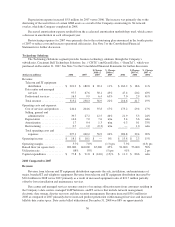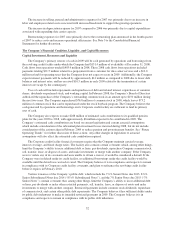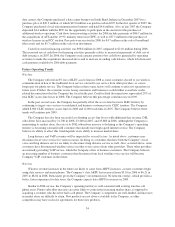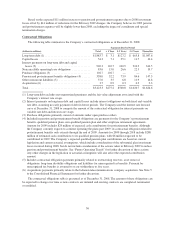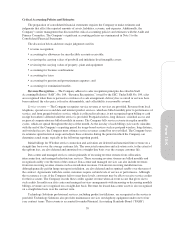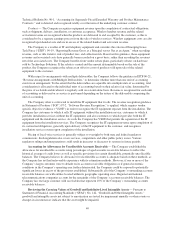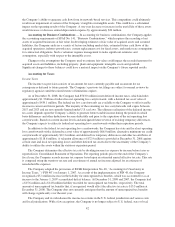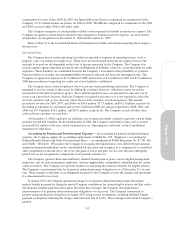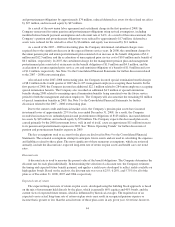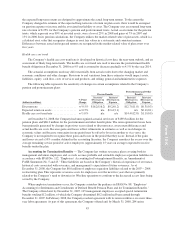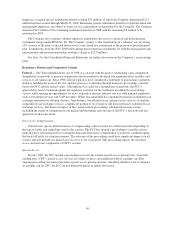Cincinnati Bell 2008 Annual Report Download - page 140
Download and view the complete annual report
Please find page 140 of the 2008 Cincinnati Bell annual report below. You can navigate through the pages in the report by either clicking on the pages listed below, or by using the keyword search tool below to find specific information within the annual report.Technical Bulletin No. 90-1, “Accounting for Separately Priced Extended Warranty and Product Maintenance
Contracts,” and is deferred and recognized ratably over the term of the underlying customer contract.
Products — The Company recognizes equipment revenue upon the completion of contractual obligations,
such as shipment, delivery, installation, or customer acceptance. Wireless handset revenue and the related
activation revenue are recognized when the products are delivered to and accepted by the customer, as this is
considered to be a separate earnings process from the sale of wireless services. Wireless equipment costs are also
recognized upon handset sale and are in excess of the related handset and activation revenue.
The Company is a reseller of IT and telephony equipment and considers the criteria of Emerging Issues
Task Force (“EITF”) 99-19, “Reporting Revenue Gross as a Principal versus Net as an Agent,” when recording
revenue, such as title transfer, risk of product loss, and collection risk. Based on this guidance, these equipment
revenues and associated costs have generally been recorded on a gross basis, rather than recording the revenues
net of the associated costs. The Company benefits from vendor rebate plans, particularly rebates on hardware
sold by Technology Solutions. If the rebate is earned and the amount determinable based on the sale of the
product, the Company recognizes the rebate as an offset to costs of products sold upon sale of the related
equipment to the customer.
With respect to arrangements with multiple deliverables, the Company follows the guidance in EITF 00-21,
“Revenue Arrangements with Multiple Deliverables,” to determine whether more than one unit of accounting
exists in an arrangement. To the extent that the deliverables are separable into multiple units of accounting, total
consideration is allocated to the individual units of accounting based on their relative fair value, determined by
the price of each deliverable when it is regularly sold on a stand-alone basis. Revenue is recognized for each unit
of accounting as delivered or as service is performed depending on the nature of the deliverable comprising the
unit of accounting.
The Company often is contracted to install the IT equipment that it sells. The revenue recognition guidance
in Statement of Position (“SOP”) 97-2, “Software Revenue Recognition,” is applied, which requires vendor
specific objective evidence (“VSOE”) in order to recognize the IT equipment separate from the installation. The
Company has customers to which it sells IT equipment without the installation service, customers to which it
provides installation services without the IT equipment, and also customers to which it provides both the IT
equipment and the installation service. As such, the Company has VSOE that permits the separation of the IT
equipment from the installation services. The Company recognizes the IT equipment revenue upon completion of
its contractual obligations, generally upon delivery of the IT equipment to the customer, and recognizes
installation service revenue upon completion of the installation.
Pricing of local voice services is generally subject to oversight by both state and federal regulatory
commissions. Such regulation also covers services, competition, and other public policy issues. Various
regulatory rulings and interpretations could result in increases or decreases to revenue in future periods.
Accounting for Allowances for Uncollectible Accounts Receivable — The Company established the
allowances for uncollectible accounts using percentages of aged accounts receivable balances to reflect the
historical average of credit losses as well as specific provisions for certain identifiable, potentially uncollectible
balances. The Company believes its allowance for uncollectible accounts is adequate based on these methods, as
the Company has not had unfavorable experience with its estimation methods. However, if one or more of the
Company’s larger customers were to default on its accounts receivable obligations or if general economic
conditions in the Company’s operating area further deteriorated, the Company could be exposed to potentially
significant losses in excess of the provisions established. Substantially all of the Company’s outstanding accounts
receivable balances are with entities located within its geographic operating areas. Regional and national
telecommunications companies account for the remainder of the Company’s accounts receivable balances. The
Company has one large customer with receivables that represent 10% of the Company’s outstanding accounts
receivable balances.
Reviewing the Carrying Values of Goodwill and Indefinite-Lived Intangible Assets — Pursuant to
Statement of Financial Accounting Standards (“SFAS”) No. 142, “Goodwill and Other Intangible Assets,”
goodwill and intangible assets not subject to amortization are tested for impairment annually or when events or
changes in circumstances indicate that the asset might be impaired.
40


